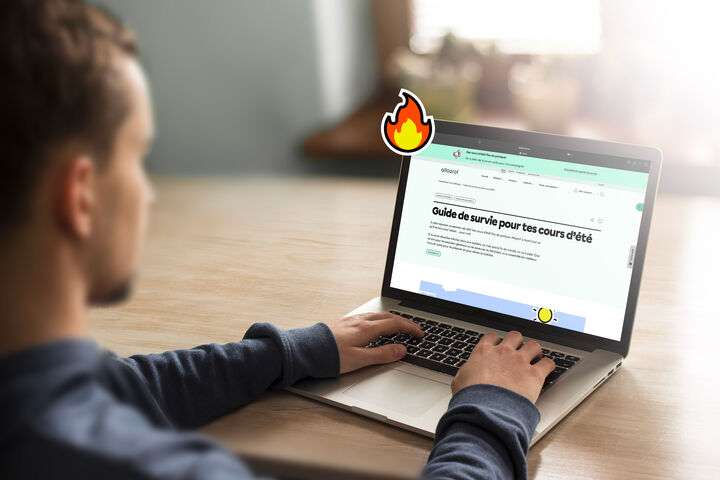Lors du 33e colloque de l’AQUOPS, un atelier a permis de démontrer plusieurs utilisations pédagogiques des codes QR, ces codes-barres abstraits qui peuvent être lus à l’aide d’une application spécifique et qui permettent de diffuser des informations rapidement. Pendant ce même atelier, les participants ont été initiés à l’intégration de réalité augmentée dans la réalisation de projets de classe. Retour…
Les codes QR et la réalité augmentée, c’est quoi ça?
C’est la question que Claude Frenette, personne-ressource au service local du RÉCIT de l’enseignement privé et animateur de l’atelier en question, a posée à la cinquantaine de participants inscrits à son atelier. En observant leurs réponses, on remarque que ces derniers semblent en mesure de définir les codes QR (simples, dynamiques, rapides, efficaces) et ce qu’ils permettent.
Codes QR non variables…
Parmi les outils de création de codes QR testés par monsieur Frenette, notons i-nigma et qrcode.fr. Tous deux gratuits, ces deux outils sont accessibles par le Web via un ordinateur ou une tablette et permettent de générer des codes simples, non variables. Le premier, en anglais, offre la possibilité d’ajouter un titre qui apparaitra sous le code QR, de pointer vers un hyperlien ou un message personnalisé de 250 caractères. Le second, en français, peut être utilisé aisément par les élèves. Il peut, bien sûr, pointer vers un site Web, mais aussi un texte personnalisé sans même nécessiter d’être branché à Internet.
Et codes QR dynamiques!
En classe, le code QR devient encore plus intéressant lorsqu’il est dynamique, c’est-à-dire que l’on peut modifier à volonté la destination de celui-ci. Un enseignant pourrait donc imprimer et afficher un code à l’intention de ses élèves afin de détailler l’atelier de la semaine. La semaine suivante, il conserve le même code, mais ce dernier pointera vers une ressource différente. Delivr.com permet de réaliser cette prouesse technologique, à condition de s’ouvrir un compte et de s’en tenir à la version gratuite qui permet de créer jusqu’à 5 codes, ce qui devrait être amplement suffisant pour répondre à vos besoins. Ces codes doivent être créés sur ordinateur, mais ils sont lisibles par les appareils mobiles.
Certains enseignants seront heureux de savoir que BridgeURL, pour sa part, est en mesure de produire un lien conduisant à plusieurs ressources à la fois. Ce lien peut, bien sûr, être transformé en code QR. Pratique lorsqu’on veut proposer rapidement aux élèves un répertoire de quelques liens! Les enseignants du préscolaire, pour leur part, pourront créer des codes QR qui pointent vers des fichiers sonores, à l’aide de QRvoice.
Un truc futé : Claude Frenette observe qu’une longue adresse URL crée un code QR complexe, donc plus difficile à lire. Il suggère de passer par un raccourcisseur de lien. Sa préférence va à monURL.ca, lequel est un service québécois qui simplifie les adresses à l’aide de minuscules seulement ou encore à l’aide d’une adresse personnalisée.
Réalité augmentée
La fin de l’atelier a été consacrée à la réalité augmentée, concept légèrement plus complexe. On parle de numériser une image à l’aide d’une application téléchargée sur son appareil mobile et de voir cette image prendre une 3e dimension (son, image superposée, animation). Difficile à concevoir? Je vous invite à procéder au téléchargement de l’application gratuite Onvert et de visionner cette galerie. De telles créations pourraient être proposées dans les cours d’arts, mais demanderont de bonnes habiletés technologiques. Anatomy 4D, Elements 4D, Aurasma et ColarApp sont d’autres applications de réalité augmentée pour iPad et Android.
Pour connaître les détails de l’atelier de Claude Frenette et des suggestions pour les utiliser en classe :
Les codes QR en classe : plus puissant qu’on ne se l’imagine
Pour accéder à sa présentation :
Codes QR et réalité augmentée : Des outils puissants pour l’apprentissage
Pour connaître les suggestions d’application pédagogique des codes QR en classe des participants :
Code QR et réalité augmentée : vos idées ici






